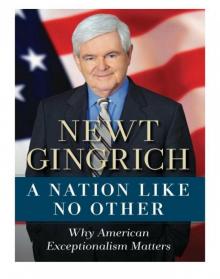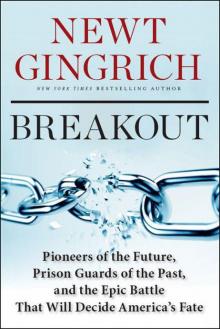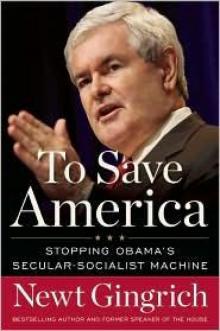- Home
- Newt Gingrich
Understanding Trump Page 18
Understanding Trump Read online
Page 18
REVIVING THE MILITARY
During his first week in office, President Trump ordered Secretary of Defense James Mattis to review the readiness of the US Armed Forces and our ballistic missile defense system, then report back with recommendations for how to rebuild our military. Trump’s first presidential budget proposal included a $54 billion increase for the military to buy ships, planes, and necessary combat supplies.
There is no question President Trump will fully follow through on his promise to rebuild the US military into the world’s standard. Our armed forces will be the strongest, smartest, and most effective they have ever been.
But we also need to overhaul the Pentagon by dramatically reducing red tape, and acquisition time and cost. Military contracts are notoriously overbudget and behind schedule. The F-35 program is only an extreme example of a widespread problem. President Trump is the perfect man to rein in out-of-control military spending. Because he knows how to negotiate, President Trump will not be caught in the typical political pitfall of being accused of being weak on the military matters for reining in defense contracts. Every dollar he saves by cutting regulations or negotiating military contracts will be another dollar that can be spent directly on our troops—either on equipment, training, or pay. Coupled with his willingness to increase spending in the right way, our military will soon be stronger than it has ever been.
The Pentagon also needs to modernize—technologically and in its thinking. Cyberattacks pose a serious risk to our economy and safety. Social media has helped terrorists take motivating propaganda to new levels. Russia has been pioneering a hybrid system of warfare that combines psychology, military power, and Internet-fueled propaganda that has helped it dominate in eastern Ukraine. A large, well-placed electromagnetic pulse could devastate our East Coast and cripple our civilization.
We need models to combat these new methods.
President Trump also needs to put an end to the rise of law-fare. The last thing we need when fighting a war is to have lawyers trapping us in red tape. Imagine how the Civil War would have gone had Lincoln’s army been hamstrung by Obama-era rules of engagement.
Finally, we also need to reverse the trend of replacing uniformed military personnel at the Pentagon with civilian employees who can unionize. Under President Obama, who favored extreme civilian control of the armed forces, the number of professional military members at the Pentagon decreased, while civilian staff increased. Civilian leadership of the military is important, but it makes no sense to increasingly rely on civilians to plan and fight our wars. We must correct this imbalance. If President Trump’s cabinet is any indication, we will soon see a lot more men and women in uniform in the halls of the Pentagon.
ELIMINATING RADICAL ISLAM
Once we strengthen our alliances and our military, permanently defeating ISIS and making radical Islamic terrorism unacceptable everywhere in the world will require supporting our Arab allies sufficiently to destroy the terrorists where they live.
But we need a successful, codified strategy for what happens next, so that power vacuums don’t simply pave the way for the next brand of evil. Our current counterinsurgency model is totally inadequate, because it doesn’t provide for a sufficiently vigorous replacement of the enemy system. When you try to secure places like Iraq or Afghanistan, the replacement system must be vigorous and able to solidify quickly. Terrorist cells like the Taliban and ISIS have been successful in taking control of war-torn regions, because they are able to regenerate more quickly than the budding governing regimes.
Developing a system wherein stable governments can outpace warlords and terrorist cells will mean our enemies will have fewer places to hide, and long-term direct US involvement will not be needed.
THE PERFECT TEAM
I am confident President Trump can achieve all these goals, and it is not just because I believe in his capabilities. It is also because he assembled the perfect team to do it.
Attorney General Jeff Sessions is an exemplary lawyer, with extensive law enforcement experience as a prosecutor for the United States government. He understands the unique challenge of balancing law and order with civil rights. Despite asinine attacks by the Left on his record, General Sessions cares deeply for all Americans and wants to see police and all our communities exist respectfully and peacefully.
General James Mattis is as good a senior officer as has served in the American military in the last generation. He’s an astounding intellectual, he’s a warrior, and he is totally patriotic. In selecting Mattis, President Trump asked for the first waiver since 1950 to allow a recent military member to serve as secretary of defense. Normally, military members must be out of uniform for at least seven years before they can lead the Pentagon. The only other general who was ever granted this waiver was General George Marshall during the Korean War.
Mattis’s professionalism and reputation is so beyond repute that Democrats put up almost no opposition to his nomination or confirmation. The Senate confirmed his nomination by a vote of 98–1. Only Senator Kirsten Gillibrand, a Democrat from New York, voted no. And a spokesman for Gillibrand later said she opposed Mattis’s confirmation only because she believed civilians should lead the military.
As an aside, keep in mind that President Trump’s early opponents criticized his national security knowledge and experience. Then, one of his first actions as president was to nominate someone to lead our armed forces who was almost unanimously approved by the Senate.
Marine General John Kelly was the perfect pick to lead the Department of Homeland Security. I have known General Kelly since he was a colonel. When I was Speaker of the House, then-Colonel Kelly was the liaison for the Marine Corps. He has given his entire adult life to serving the country and remained steadfast even after he lost a son in combat. Before President Trump appointed him, General Kelly had just finished leading the Southern Command, which oversees US military operations in all of Latin America. There is no one more skilled, knowledgeable, or qualified than General Kelly to secure and protect our southern border, to implement and operate a safe immigration system; or to keep terrorists and drug dealers out of our country.
Some have questioned whether President Trump has leaned too heavily on former military members to lead his cabinet, but the American people don’t think so. Pew Research Center released a report in October 2016 that found that almost 80 percent of American adults trust the military to act in their best interest.9 According to the report, “one-third of the public (33 percent) has a great deal of confidence in the military and an additional 46 percent say they have a fair amount of confidence. The high ranking of the military is consistent with a 2013 Pew Research Center survey, which found 78 percent of the public said the military contributes ‘a lot’ to society.”
Meanwhile, the October report found that only about 27 percent of Americans trust elected officials, and only 38 percent expressed trust in the news media.
Vice President Mike Pence could also be instrumental in developing meaningful immigration reform. When he was a congressman, Vice President Pence worked with Senator Kay Bailey Hutchison and Helen Kriebel of the Kriebel Foundation to develop an accurate picture of how normal Americans felt about immigration. Had President Bush worked with Pence and Hutchison, we might have solved many of our immigration problems in 2006.
Then you get to Rex Tillerson, who has had a tremendous career going around the world and successfully negotiating agreements with foreign countries on behalf of Exxon Mobil—an American company. This will be a significant change from the legacies of Hillary Clinton and John Kerry, who spent years unsuccessfully negotiating with foreign powers.
The most immediate change our allies and adversaries around the world are going to see is that Tillerson actually represents America and America’s interests.
There is a great story former secretary of state George Schultz used to tell. When Schultz met new ambassadors before they were sent overseas, he would take them over to his globe and ask them to poi
nt to the country they were going to represent. Four out of five times, Schultz would say the new ambassadors would point to the country where they were going—not the United States, which is the country they would be representing.
The logical conclusion you can draw from that is for a long time there has been a systematic cultural problem in the State Department that has caused 80 percent of our ambassadors to be confused about what country they are supposed to be representing abroad.
We now clearly have a team that will ensure that the United States is safe again.
When we would talk during the campaign, Trump would emphasize that his experience as a businessman led him to understand the impact of both taxes and regulations. He was confident that he understood how business leaders think—and that an aggressive pro-American trade policy, combined with less regulation and lower taxes, would lead to a dramatic increase in economic growth.
CHAPTER ELEVEN
THE AMERICAN COMPETITIVENESS BOX
In chapter 7, we established that for the last half century, the United States has adopted trade agreements that benefit our trading partners more than America.
With a few exceptions, the US trade balance—the amount of money we spend or gain in trade—remained positive from 1950 until the mid-1970s. During that time, the US trade balance ranged from $500 million to $1 billion, according to the website tradingeconomics.com.1 The balance became erratic, running slightly negative, from 1977 through the early 1980s—dropping to an at-the-time historic low of −$15 billion. That was the start of a dramatic trend wherein the United States bought more than it sold and hemorrhaged jobs and money into the rest of the world, due to overgenerous trade agreements.
At the same time, we’ve also created the most antibusiness tax system in the developed world. Because of this, for the last decade we’ve experienced just 1.9 percent growth, dramatically less than the historic average. American competitiveness has withered, and it must be restored. Americans are gambling on President Trump to break the country out of this pattern. If he doesn’t break us out, we will fail as a country.
TAX CUTS, MORE THAN TAX REFORM
Trump understands that job creation must be at the center of his presidency. As a candidate, President Trump said his economic agenda could be summed up in three words: “jobs, jobs, jobs.”
If eight years from now, President Trump, like Reagan in the 1980s, can point to nineteen million new jobs, the American people will regard his presidency as a success.
It was the dramatic income tax cut in 1981 that led to the explosive economic growth under President Ronald Reagan. It was the capital gains tax cut in 1997 that led to the economic boom of the late nineties.
So, to boost job creation, President Trump will take a cue from history and work with Congress to cut taxes.
Tax cuts should be emphasized more than tax reform. Reforming the tax code will not create jobs on its own. Emphasizing tax “reform” will lead to Washington bean counters insisting on revenue neutrality—basically raising taxes in one area to cut taxes elsewhere. This is futile for job creation. In the short run, the tax increases always hurt more than the tax cuts help.
Instead of revenue neutrality, Trump and the Republican Congress should seek “deficit neutrality”—based on Obama’s deficit baseline. This will create space for tax cuts by finding room elsewhere in the budget.
Unused federal assets should also be monetized to create nontax revenue that could offset tax revenue for tax cuts. This includes leasing non–environmentally sensitive federal lands for energy and mineral development and renting or selling federal housing stock and office space.
Trump and Congress should also insist on measures to crack down on waste and fraud, especially in our public health programs. There is an estimated $110 billion per year in fraud occurring in Medicare and Medicaid alone. Just cutting this in half would create room for over $50 billion more per year to be returned to the American economy via tax cuts.
By insisting on these steps and more, Trump and the Republican Congress could create room for a revolutionary job creating tax cuts without adding a penny to the deficit. Here is what that agenda could look like:
BUSINESS TAX CUT
The United States has the highest corporate tax rate among developed countries in the world at 38.92 percent, according to the Tax Foundation. It is the third-highest corporate tax overall. Only the United Arab Emirates and Puerto Rico tax businesses at higher rates. The world’s average business tax across 188 countries and tax jurisdictions is 22.5 percent, and that is down from 30 percent in 2003, Tax Foundation figures show. Our rate is nearly 17 percentage points above average, and the average is dropping, so we are immediately at a disadvantage for attracting businesses. Meanwhile, Europe, as a region, has the lowest corporate tax rate at 18.88 percent.
If you were going to build a factory to make and sell widgets, where would you choose to set up shop: somewhere you would pay lower-than-average taxes, or the United States, where you would pay the third-highest rate in the world?
We must cut corporate taxes so businesses will want to invest in the United States and hire American workers. During the campaign, President Trump suggested lowering the rate to 15 percent, while Republican lawmakers are crafting a plan that would bring the rate to 20 percent. Either rate would be an enormous improvement that would immediately put the United States in a better position to attract business and spur growth.
HOW A BORDER ADJUSTMENT TAX FITS IN
The United States is one of the few developed countries that does not tax imports and reward exports. Meanwhile, companies that remain in the United States and provide jobs to American workers are forced to pay taxes on their exports to other countries.
This means our current tax system is set up so that companies are better off manufacturing products in other countries, where they face lower taxes and fewer regulations, can pay lower wages to workers, and can sell into the huge US market penalty-free.
If we are serious about reversing the trend of jobs and money fleeing the country, we need to rectify this imbalance. Speaker Paul Ryan has a plan that involves implementing a border-adjustment tax, which is exactly the kind of system we need.
To be clear, the point of a border-adjustment tax is not to generate tax revenue to offset other cuts—we’ve discussed why this is harmful. It is to create jobs in America by putting us on an equal footing with other countries.
A border-adjustment tax is applied to all imported goods. Exports are not taxed. Naturally, this tax scheme incentivizes businesses that want to sell in the United States as well as in other countries to move here, because it allows them to avoid the import tax. Additionally, it gives large manufacturers good reason to expand their existing US facilities instead of outsourcing jobs to facilities in other countries.
More than 160 other countries have a value-added tax on imports, or a border-adjustment tax. Some have both. Countries aside from the United States that don’t have such taxes include North Korea and South Sudan.
Critics of the border-adjustment tax say imported goods will be more expensive, because the border tax will be passed on to consumers. The standard counterargument is that the dollar will strengthen and balance out the price increases. But here’s a simpler response for those concerned with expensive imports: we’d rather people buy American-made goods anyway. That aside, more companies coming to the United States means more American jobs. More Americans with jobs means more Americans with money in their wallets. If someone wants to pay more for an imported car, he or she would have that choice.
Some manufacturers who have built facilities in other countries would bear much of the burden early on, until they move more operations to the United States. But despite this, in February 2017, I met with thirty major American investors in Colorado. Nearly all of them voiced full support for a border-adjustment tax in America.
If President Trump and Congress are able to quickly cut taxes on businesses, and reform our tax system in a wa
y that will attract business to America, our job market will see an immediate and lasting revival. According to the Tax Foundation, Speaker Ryan’s tax plan could create about 1.7 million American jobs, and boost US production by more than 9 percent.
ELIMINATING THE CAPITAL GAINS TAX
Cutting the corporate tax rate and instituting a border-adjustment tax will incentivize American business investment and increase the number of jobs in the country, but we also must incentivize Americans to support business and their own retirements. The best way to do that is to eliminate the capital gains tax.
Scrapping the capital gains tax, lowering the corporate tax rate and initiating a border-adjustment tax would supercharge the American economy.
When I was Speaker of the House of Representatives, cutting capital gains was instrumental for balancing the budget. I will talk more about balancing the federal budget in chapter 13, but the impact of getting rid of capital gains taxes is relevant here.
The modern Left has convinced its voters that the capital gains tax isn’t of interest to most Americans, because it is paid only by the wealthy. And it’s true that households making more than $250,000 a year pay the clear majority of capital gains taxes. But the Left has also convinced liberal voters that increasing the tax would cause the wealthy to pay more in taxes—which is simply untrue.
The actual impact of increasing the capital gains tax is that wealthy investors, who hire smart accountants, invest less. They put their money elsewhere, and the US economy—and federal tax revenues—suffer. Higher taxes yield less investment, and lower taxes yield more investment.

 1945
1945 Collusion
Collusion Trump's America
Trump's America Shakedown
Shakedown A Nation Like No Other
A Nation Like No Other To Try Men's Souls - George Washington 1
To Try Men's Souls - George Washington 1 Pearl Harbor: A Novel of December 8th
Pearl Harbor: A Novel of December 8th Valley Forge: George Washington and the Crucible of Victory
Valley Forge: George Washington and the Crucible of Victory To Save America
To Save America Grant Comes East cw-2
Grant Comes East cw-2 Victory at Yorktown: A Novel
Victory at Yorktown: A Novel Days of Infamy
Days of Infamy The Battle of the Crater: A Novel (George Washington Series)
The Battle of the Crater: A Novel (George Washington Series) Breakout: Pioneers of the Future, Prison Guards of the Past, and the Epic Battle That Will Decide America's Fate
Breakout: Pioneers of the Future, Prison Guards of the Past, and the Epic Battle That Will Decide America's Fate Pearl Harbour and Days of Infamy
Pearl Harbour and Days of Infamy Pearl Harbour - A novel of December 8th
Pearl Harbour - A novel of December 8th Understanding Trump
Understanding Trump To Save America: Abolishing Obama's Socialist State and Restoring Our Unique American Way
To Save America: Abolishing Obama's Socialist State and Restoring Our Unique American Way